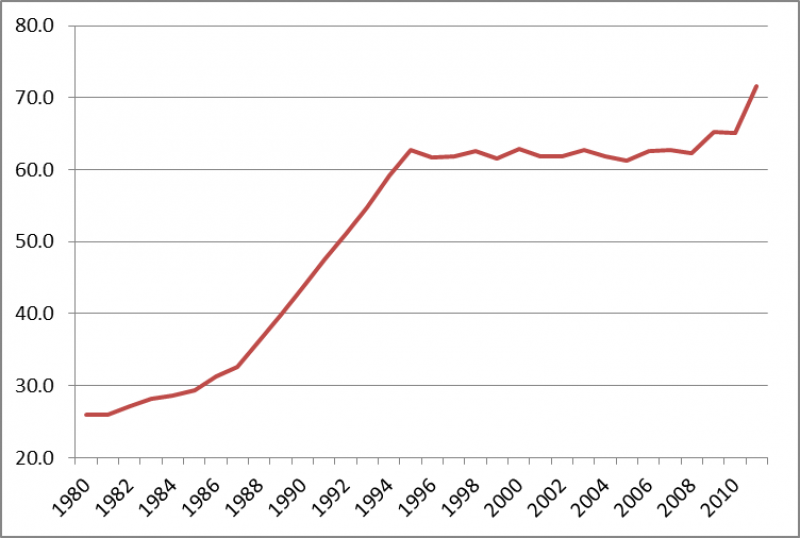
It includes comments and ideas for discussion concerning a ten-year horizon and sketches out an approach for developing a medium-term strategy, without in any way claiming to raise all the questions or provide suitable answers. Its principal aim is to initiate discussion on the agenda.
In 1985, the Education Minister, Jean-Pierre Chevènement, launched a programme to increase the percentage of students passing the national Baccalaureate examination to 80% by the year 2000. At that time the number had languished below 30% for several years. Ten years later, in 1995, the figure was above 60% (Chart 1). While some consequences of such a rapid change can be criticised, France with 500,000 more students than in 1985, had started its educational catch-up, and increased access to further education ensuring that academic achievement will no longer be monopolized by a minority. This objective was clearly stated and motivated people.
Chart 1: Success Rate at the Baccalaureate, by Generation, 1980-2011

Recent French history offers other similar examples: the programs for telecoms equipment and energy independence implemented in the 1970s; the single currency introduction in the 1990s; the harmonisation of European university systems within the Bologna process, or the cancer initiatives in the years 2000. On each occasion, a long-term objective was set, although it often seemed totally unrealistic when formulated. It guided public action, galvanised those involved and public opinion followed. Whatever one might think of these undertakings, whatever view one might have about the undesirable effects of such and such a project, they were ambitious and the changes they brought were significant.
Other countries besides France have also managed to implement far reaching transformations within a decade. The case of Germany comes immediately to mind: in March 2003, when the Chancellor Gerhard Schröder presented his reform programme, Germany was the sick man of Europe. Ten years later, income inequality may have increased, but unemployment is at an all-time low and the country’s economic prosperity is the envy of all. Sweden is another striking example. The financial crisis of the early 1990s provoked radical rethinking and caused a complete overhaul of the way social security was implemented, without destroying the fundamental social model. Such success is all the more remarkable when comparing these cases with what happened in Japan, where a violent financial crisis hit the country in the early 1990s, but where its leaders were unable to tackle the difficulties with the required determination to resolve the problems. At the international level, one can also mention, the Millennium Development Goals, which were developed in favourable economic conditions and enabled a concentrated effort to such an extent that many of them have been achieved before the expected due date of 2015.
These examples show that public action loses none of its reforming ability as long as the vision is sufficiently long term and the objectives are clearly stated. Ten years is the right horizon for structural decisions that:
- clearly define the long-term goal;
- give continuity to collective action across changes in government;
- enable throwing off quantitative logic - how much more of this, how much less of that - and embrace the need for qualitative changes;
- require reasoning in terms of asset stocks that determine the health of a nation - competence/skills, technical facilities, housing, debt - rather than just in terms of flows;
- lead institutions to reform themselves in order to meet the objectives they are given.
Five years is a political horizon, whereas ten is a societal one. A ten-year perspective has the advantage of being both sufficiently close for people to identify with, and sufficiently distant for the necessary institutional and material investments to bear the desired fruit. For these same reasons, it also allows for debate and dialogue.
However, for several years now, French society has had a blurred vision of where it is going. This is undoubtedly a handicap, as the absence of a clear collective vision with which each citizen can identify and work towards weakens the collective will and favours the attitude of every man for himself. France’s blurred vision is also a source of questions for its international trading partners and observers that have difficulty in discerning what the country wishes. From the outside too, there are questions.International trading partners and observers have difficulty in discerning what the country wishes to be and even more in understanding what means it is bringing to achieve its objectives.
Thinking and debating about what the French people wish to be ten years from now, fixing the roadmap ahead on the basis of such discussion, and implementing the actions to be taken will enable the country to come out from its current confusion. France in 2013 is not the France of the 1970s, nor even that of the 1990s. The priorities and urgencies of today are not the same as they were. The State is no longer able to decide for society as a whole. Continuity and consistency are essential to address the issues to be tackled, and adopting a rigorous method will be extremely worthwhile.
In this context, the current briefing paper is divided into three sections. The first provides a brief snapshot of the world, of Europe, and of France in the next ten years. The second dwells on three key collective choices that are particularly important for French society. The third suggests methodological elements and some reference points as an aid to producing a ten-year strategy.



